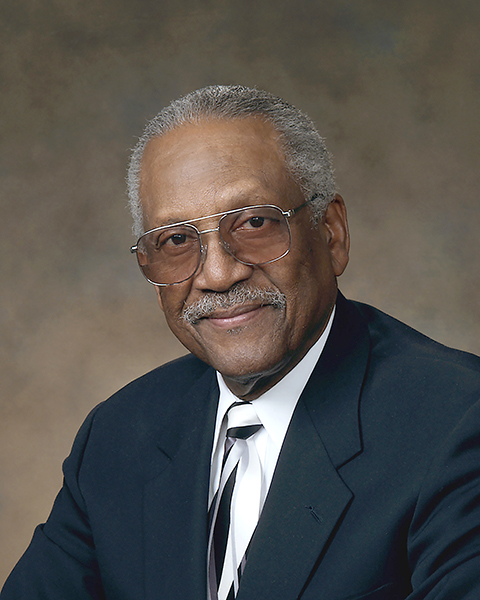Black History and Seventh-day Adventist History

This message was preached at Loma Linda University Church in 2013 for Black History Sabbath. The text has been minimally edited for readability.—Editors.
The healing power of something better. The healing power of something better. The principle of something better is a true and traceable cause of humanity’s most noble and productive energies. We see the concept of something better at work in the founding of our nation, whose pilgrims were drawn to these shores in search of religious and political freedom.
As this month of African American history reminds us, we see the hope of something better at work, in the remarkable climb of the descendants of American slavery to present status. My proposal today is that as we rightly consider the role of Black Americans as healers in today’s multicultural society, we also celebrate appropriately the healing they themselves have experienced by the innovating principle of something better. While many of the ships that brought the slaves to these shores had such suggestive names as Liberty, Desire, Brotherhood, and one, even the Good Ship Jesus, their human cargo had no such outlook.
From the Darkest of Days
Shelved down and shackled together for weeks in the putrid bellies of the roiling ships, those who survived were disgorged upon these shores, besieged and bewildered. They were shoved upon auction blocks, where they were poked and prodded, beaten and bartered, and delivered into the most hopeless brand of slavery ever known to history. What distinguished American slavery as so depressingly unique is that it had no manumission or exit clause. From as far back as Hebrew history, slave systems all had provisions whereby ostensibly, at least the slave could gain his or her freedom by accumulation of earnings or years of service. There was no such allowance in the slave codes of America. As a result, slaves were forced to labor, day after depressing day, year after weary year, decade after dreary decade with no hope or possibility of something better.
Often, they were fed like animals where they thrust their grimy fingers into the mush, hoping to gain strength for yet another day of unrequited labor. They lived in tattered rags and slept on muddy floors and rose each morning to function at the mercy of avaricious and often rapacious masters. They lived and died in this pit of misery without a sliver of hope, and their brief longevity contained no rainbow of deliverance, no ray of freedom, no light at the end of the tunnel. They were erased from home, as one poet puts it, hope unborn had died. There was for them no hint of healing or dent of something better. None, that is, until 1671, when the Bible promise of a better life in a better world to come was brought to a small number of slaves on the Virginia plantation by a group of Friends, or Quakers.
They were followed in rather rapid succession by the Society for the Propagation of the Gospel in Foreign Parts, a forum that came from England, the Episcopal Church, the Anglican Church, the Methodist Church, and the Presbyterian Church in that order. These brave missionaries risked their very lives by invading the properties of slave owners, as did the slaves who dared listen. Nevertheless, they found clever means to communicate with their benefactors and spread the good news of something better across the cotton rolls in whispered excitement and from plantation to plantation, by the coded beat of their drums. The welcome information, rudimentary as it was, created singing in their hearts and a brand-new genre of music to be labeled the Negro spiritual.
Knowing that their masters would not be pleased, they turned their cooking pots upside down to mute their voices and sing with soulful expectation. Our prophet affirms the reality of many slave conversions even under these circumstances when she wrote as she describes the Second Coming: “Then commenced the jubilee when the land should rest. I saw the pious slave rise in victory and triumph and shake off the chains that bound him while his wicked master was in confusion and knew not what to do.”1 Surprisingly or not surprisingly, the ennobling power of something better soon developed in the slaves a thirst for deliverance in this life as well.
The few masters who thought that teaching them Bible verses would suppress any desire for something better were on the wrong side of scriptural dynamism. On the other hand, those masters who sought to keep them from Scripture, lest it stir them to rebellion, headed right. That is because evidently, in the sequence of godly urgings as equaled in our daily praying, the kingdom-come appeal for future bliss is precursor to the “give us this day, our daily bread” plea for present satisfactions. It was thus preordained and predictable that the Bible principle of something better would drive the slaves to overt resistance, and it did so in a number of ways. The first was a spate of physical attacks, spearheaded by zealous slave leaders who led their ragtag followers in violent revolution against their owners.
Principal among them were Gabriel Prosser, Virginia, 1800, who, inspired by Joshua 15, saw himself as the Black Samson commissioned to lead God’s ill-equipped people against highly superior foes. Another was Denmark Vesey, South Carolina, 1822, who, charged by the life of Moses’ successor, claimed himself as the Black Joshua. Most notable of all, Nat Turner, Virginia, 1830, who, when trapped and caught after considerable bloodshed, was asked moments before he was hanged if he had any final words. He replied with convicted resolution: “They hanged Jesus, didn’t they?” A more practical and second way in which the something-better principle generated resistance was in the Underground Railroad, which spirited thousands of slaves from the cotton fields of the South, all the way north to the snowy fields of Canada.
Freedom Must Come
The conductors who led them through and around dangerous paths were Christians. The stations where they were temporarily housed were Christian churches, homes, and barns; hiding by day and following their starry GPS by night. They waded through mosquito-infested swamps, evading bounty hunters and bloodhounds, trudging bravely and tirelessly on to freedom ahead. The third and most determinative assault upon the institution of slavery fueled by the something-better dynamic is seen in the aggressive approaches of the abolitionist movement. The abolitionists came in two categories. First, there were Christian terrorists, such as John Brown, the fiery Puritan preacher and architect of the ill-fated Harpers Ferry, Virginia, raid of 1859. He, along with his colleagues, was captured and hanged, each riding to the gallows sitting on the individual coffins soon to receive their remains.
There were Christian pacifists such as William Lloyd Garrison. There were pastors, educators, editors, statesman, who wrote and spoke with great passion against human bondage, and who, with the superior weaponry of moral sanctioning, successfully pricked the nation’s conscience regarding slavery and hastened its demise.
The influence of the Christian church and its ethos of something better did not cease with the end of slavery. It operated with needed efficiency in the post-slavery decades of the nineteenth century as well. With slavery’s end, there were nearly four million Blacks set adrift in the land. The vast majority without skills other than those they had exercised in servitude. There was also the bitter resentment of their former owners coupled with the hapless vulnerability of this uneducated mass of homeless wanderers, which made their plight, except for the psychological damage of slavery, in some ways worse than their formal lot.
They had been ushered into freedom under the protecting watch of the Union Army, but they had no Moses to lead them and no pillar of cloud by day or pillar of fire by night to guide them. Compounding their plight was the removal of federal troops in 1876 by President Rutherford B. Hayes. This was done in fulfillment of his promise to do so if the South would vote for him. Twenty years later, in 1896, came the establishment of “separate but equal” in the case of Plessy v. Ferguson. I am proud to say that the children of slavery clawed their way up through such daunting obstacles, and it was chiefly the Christian church with its message of something better that provided the wherewithal for their survival and growth. Early on, it was the White church only, primarily in the South, that led out in the healing process. There was no Black church.
But in 1787, the first Black Christian congregation—the African Methodist Episcopal Church—was organized in Philadelphia, Pennsylvania. Other Black congregations followed during the next three decades. By 1918, what became known as the Black Christian church with its many branches was fully operative. It was that group, which today houses approximately 80 percent of all Black Christians in the United States, aided by their White Christian counterparts, who provided the primary principles for African American protest and progress during the twentieth century. That support was direly needed, not only in the South but in the North, which is where Southern Blacks migrated in huge numbers around the time of World War I.
A Way Forward?
Pushed by nature’s droughts and human cruelty and pulled by the promise of factory jobs and social freedoms, they made their way from down south to “down north,” as Dr. King would later derisively label it. There they found themselves unprepared for the bitter cold of winter, the crowded landscape, and the ever-present reality of urban crime. Then there were the 1930s and the awful Depression years followed by the 1940s, during which World War II produced more factory jobs and the second great migration of Blacks. Yet again they encountered the same woes and conditions as they found in the first. After that came the ’50s and ’60s with bitter bloody riots. Some of us remember them before and after the triumphs of the Civil Rights Movement.
Since that time the continued challenges of poverty, joblessness, skills, education, prenatal and elderly care, and the crippling lack of access to quality health care in general, carry on. While it is accurate to say the Christian church has been foremost in the healing of Black America, that is not to say the church has done all that it could or should have done. But again, in comparison with all other institutions, its grades are clearly superior. It was the Christian community that first said “No” to the sin of slavery and “Yes” to its disenfranchised survivors.
It was the church, during the decades following slavery when Blacks were denied attendance at the colleges and universities of the land, that founded their own faith-based institutions, primarily in the South. It did so in such proliferation that H. Richard Niebuhr in his book The Social Sources of Denominationalism, described their growth as mushrooms after a summer rain. It was the church in 1905 that supplied the charter members of the Niagara Movement (later to become the NAACP) and the Civil Rights Movement its primary spokespersons, transportation systems, meeting houses, and its many marchers and martyrs—both Black and White.
The Church and the Struggle
But how did we, the Seventh-day Adventist Church, relate to the needs encountered by this people? This people, the only minority in the land brought here against its will. This people, the only racial group whose males were castrated for spite and lynched for sport? This cultural unit whose women were so abused by their masters and then later, mixing with Indian tribes, thus effectively eliminating the pure African strain that was brought here, resulted in the redefinition of slave descendants from African to colored. This group, decreed by the Supreme Court and the famous Dred Scott Case of 1857 as having no constitutional rights that the White man was forced to honor. The only group in American history whose individuals—as voted by the infamous Philadelphia compromise in July 1787—were legally declared three fifths of a person, if you can imagine that. This group of people that has for most of American history been the last ones hired and the first ones fired. And whom, largely because of the various boundary-maintaining mechanisms imposed by the nation, have proven insoluble in the cultural melting pot proposed by Thomas Jefferson as America’s ideal construct.
Given the time of our origin in 1863, which began as slavery ended, is a matter of good news and bad news. The bad news is that our theologians have tended to limit the something-better principle first, by framing it as a strictly spiritual notion. Second, by relegating it to the glory kingdom to come, what cynics have coined “pie in the sky” or the “way by and by,” we have historically functioned within the parameters of the government’s decisions regarding such issues as the fugitive slave law, separate but equal, racial quotas, miscegenation, voting rights, and the like. Change for us has usually come only after the government has turned course; by changing its laws and admitting its errors. What does this say? We preachers of prophecy have for the most part been less than prophetic in matters of social justice.
The consequences in Adventist American society have been much frustration, and the loss of literally thousands whose understanding of God, and something better in the here and now would not allow them permanence in a structure where this was not a present priority. But there is good news as well. The good news is that many of our founders—including John Byington, our first General Conference president—were abolitionists. The Seventh-day Adventist Bible Commentary, volume 10, says that Byington, elected to office in 1863, “was actively antislavery. He regularly entertained Indians and Blacks in his home, and is said to have maintained, of all things, an Underground Railroad station at Burke Bridge, New York, where he lived on a farm.” Good for him.
The good news is that our church prophet, Ellen White, from her earliest years of ministry, issued repeated rebukes against the slave trade and was so adamant a crusader for justice that she advocated civil disobedience rather than conformity to the evils of existing law. Her words were, “When the laws of men conflict with the word and law of God, we are to obey the latter, whatever the consequences may be. The law of our land requiring us to deliver a slave to his master, we are not to obey, and we must abide by the consequences of violating this law.”2 The good news is that in spite of defections from the ranks of Adventism by several notable Black leaders, we have not, as is the case with most recognized denominations, suffered major cynicism.
That is largely because of the shining examples of faithful church members such as Ruth Jeannette Temple, M.D., who was born in Natchez, Mississippi, in 1892. She moved to Los Angeles in 1904 as a young adult, received a five-year scholarship to the College of Medical Evangelists, and in 1918 became the first female to graduate from what is now Loma Linda University. Despite prevailing racial attitudes, she served on the teaching staff of White Memorial Hospital, held prominent positions with the Los Angeles County Department of Public Health from 1942 to 1962, and I’m glad that I knew her.
The good news is that we were blessed with a succession of sacrificial ministerial leaders such as F. L. Peterson, the first Black graduate of Pacific Union College in 1916. He graduated in musicology and is my wife’s father. He became not only a teacher and a preacher, but the dominant African American leader in Adventism during his lifetime. He became a vice president of the General Conference in 1962, and was joined by such other stalwarts as E. E. Cleveland, C. D. Brooks, and many, many others whose preaching has been critical to the index of Black Seventh-day Adventism. The good news is that the world church was led by a succession of General Conference presidents beginning with W. H. Branson in 1950 and followed by R. R. Figure, R. H. Pierson, and Neal C. Wilson, who, at critical times during the middle and latter decades of the past century when things were bubbling and boiling, moved the church forward with regard to fairness and equality.
The good news is that six of our nation’s nine union conferences have or have had Black presidents. The good news is that the North American Division elected a Black president, Charles E. Bradford, in 1979; three full decades before its territorial counterpart, the United States of America, would do so in the person of Barack Obama.
Has the Time Come?
Is this all telling us that the time has come, that the patience so badly wounded by 250 years of slavery and 90 years of legally defined inferiority has sufficiently healed? To put it another way, has this group achieved parity in terms of professional, political, and economic status in society and/or the church? The answer is no. Not while comprising 13 percent of the population and less than 4 percent in critical professions as law and medicine, not with 3 percent of the Ph.D.s and 40 percent of the jail population, not with earning paychecks that are 30 percent less than the national average, not with eight years less longevity for men and seven years less for women, and infant mortality being 2.3 times that of the national average. As regards the matter of interracial fellowship, have we achieved or are we soon likely to achieve a state of harmony that will allow us to relax or abandon our efforts at healing?
Again, the answer is no. In spite of that knowledge and the hardwired social realities about us, we modern-day Christian abolitionists, if you please, are all of us on the gospel obligation to work for something better than present conditions, and those efforts must involve better things than intermittent pronouncements regarding racial harmony. They should include, first of all, I believe, honest desegregation, or an open-door policy for all. We should not feel guilty because ours is a flower garden rather than a monolithic society, especially given the fact that a so-called colorless society is sociologically impractical, organizationally untenable, and theologically unsubstantiated.
Critical to this view is our comfort with the knowledge of the day of Pentecost. It is still a fact that each distinctive culture hears the gospel best in its own socialized idiom, that it is wrong to label a group racist or segregationist because its members choose to worship in that language without restrictions upon others. Such worship should not be viewed as racist or segregationist, but as an expression of praise that honors God in the very real and legitimate contours of that people’s experience. Second, we must, while maintaining the standards of excellence for which our institutions are known, continue to expand our community-based services for the underprivileged. That should include not only boots-on-the-ground ministries where these people live, but again without diluting operational excellence on programs that address their practical needs.
Third, our institutional calendars, churches, and otherwise would do well to include year-round education programming, involving all of its significant cultural components, all of them as means of strengthening and healing relationships. Four years ago my mother died at age 96. Her mother was a girl of 15 when she heard the message from the decks of the Morning Star, the boat built by the prophet’s son Edson, which he sailed down the Mississippi River from Lake Michigan for the purpose of educating the children of the recently freed slaves. My grandmother was one of the original 16 students at what was then Oakwood Industrial School, the fortieth of such schools to be started by churches in that era.
Having gone there in 1896, she earned her nursing certificate and later served as one of Ellen White’s chambermaids at the old Melrose Sanitarium in the Boston area. Soon after, she married Robert L. Bradford, a Seventh-day Adventist minister, and became the mother of Eva, her fourth child, my mother; and Charles, her eighth, who was the former president of our division. I invited her when she was yet an octogenarian to speak at the Abundant Life Church in Las Vegas, where I was pastoring. And when I asked her that morning about her topic, reminding her that it was Black History Sabbath, her reply was, “Don’t worry. I am Black history.” And she was.
Born just 47 years after slavery and steeped in Adventism, she was an encyclopedia of historical information, and an eyewitness to almost a century of transitional events in society and the church. Her health deteriorated, and she closed her eyes and stopped communicating. So, it was with great surprise when she was asked a few days before the 2009 inauguration if she knew who the president was, that she opened her eyes and said, “Yes. Bush. But not for long.” In that reply was contained all the soul of pride of one whose great-grandfather’s name was changed to Bradford, that of the White family relocating from Alabama to Kansas on whose wagon his parents placed him knowing that his opportunities for something better would be enhanced.
The One Who Is Something Better
It was the answer of one whose years on earth double those that intervene between the end of slavery and her birth, and who through those decades had witnessed our people climb from the outhouse of legal discrimination to the White House of international recognition. It is absolutely stunning—unspeakably, incomprehensible, and humanly inconceivable—that Jesus was willing to undergo the exact reverse of that process in order to rescue us from the slavery of sin. He left the health and happiness of glory, the conduct of universal affairs, and the praise of adoring angels to bring us something better.
Because of that, He is not only the courier of something better, He is something better.
As Hebrews affirms, He is a better tabernacle, a better hope, a better resurrection, a better reward, a better sacrifice, and a better High Priest; Himself the offering, Himself the offerer.
It is into His nail-pierced hands—the hands that now present to the Father His faultless blood as something better than our efforts for forgiveness; His righteous robe as something better than our relative perfection—that we lodge our pleas and rest our hopes. Our pleas for tolerance to accept difference, for boldness to confront oppression, and our hope of His soon return and the inauguration of the peaceable kingdom where the redeemed will never cease their enhancement. And we who now see through the glass darkly will see Him face-to-face, ever reveling in the untarnished fellowship that we will have with one another, and in unmarked, unmitigated, unbroken, unhindered, unwavering, unlimited, untroubled, untiring, unending communion with Him.
But until then, we are all pilgrims searching for tomorrow. Our emancipation was granted on Calvary.
Our full deliverance will soon be here, and we can keep hoping and searching and growing under the catalysts, under the principle, under the grand and glorious prescription of something better until our Lord shall return. Do you join me in that hope?
To listen to Calvin Rock as he presented this sermon at Loma Linda University Church, click here.
1 Ellen G. White, Early Writings (Washington, D.C.: Review & Herald Pub. Assn., 1882), p. 35.
2 White, Testimonies for the Church (Mountain View, Calif.: Pacific Press Pub. Assn., 1868), vol. 1, p. 202.








